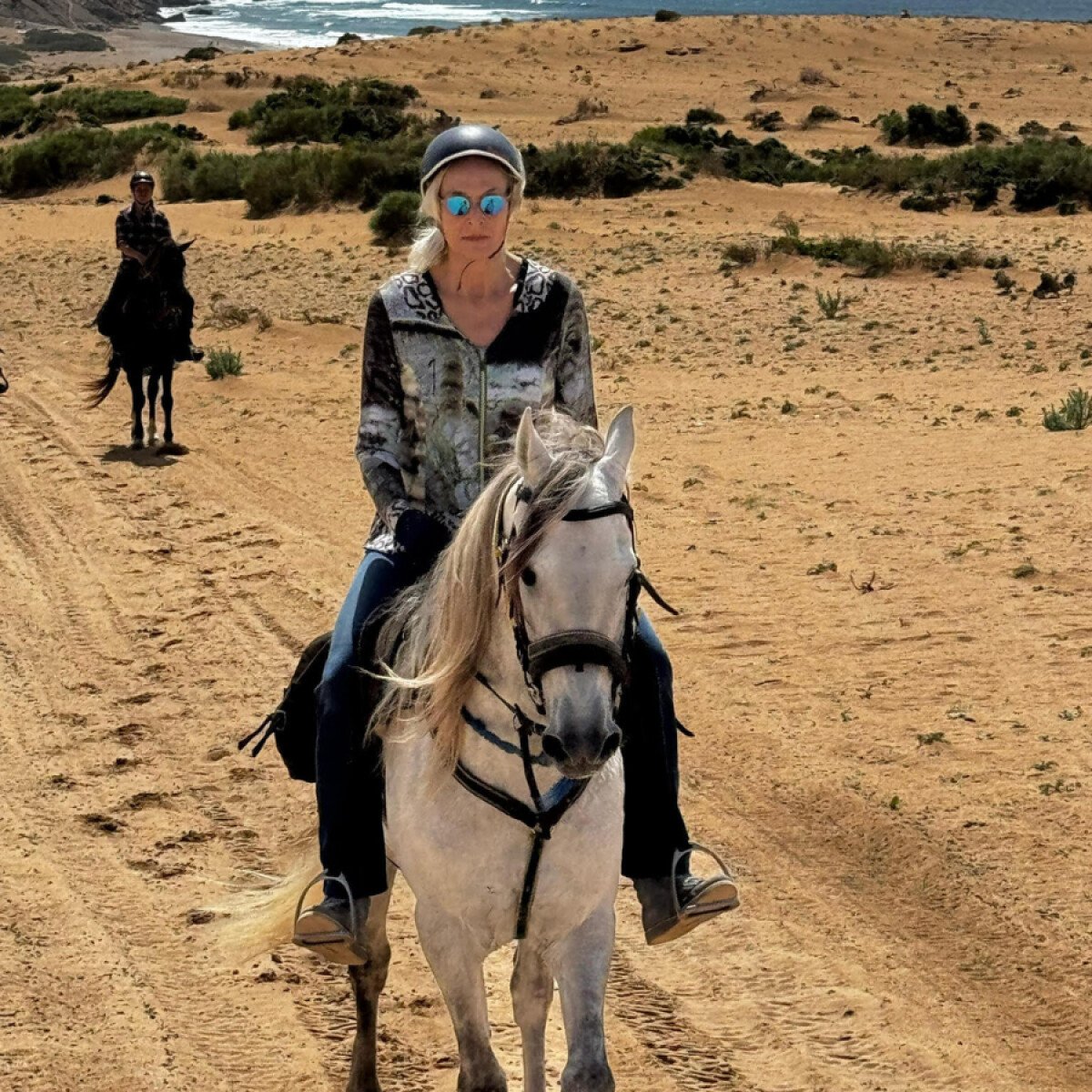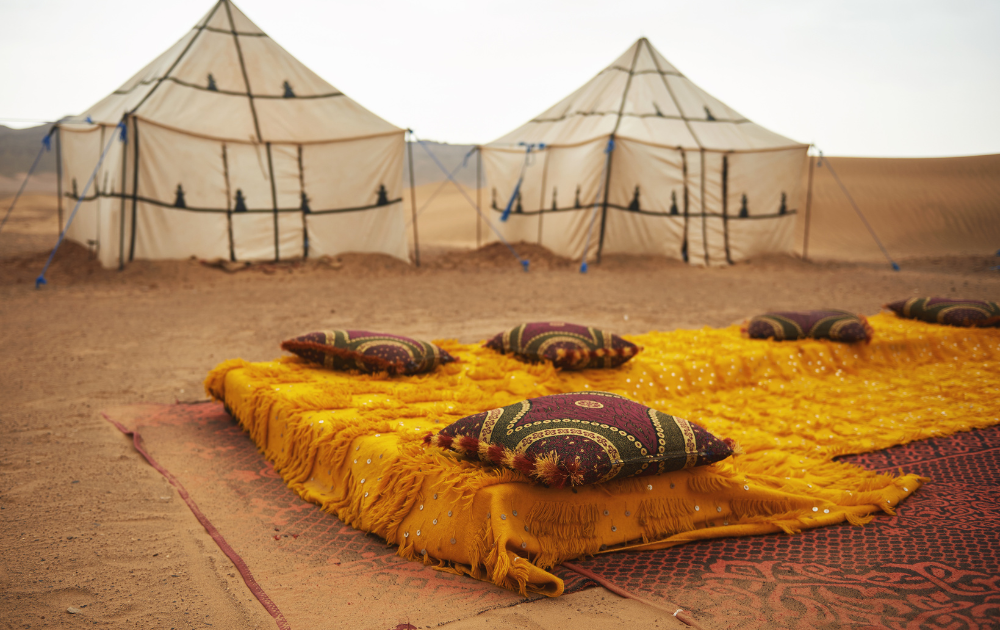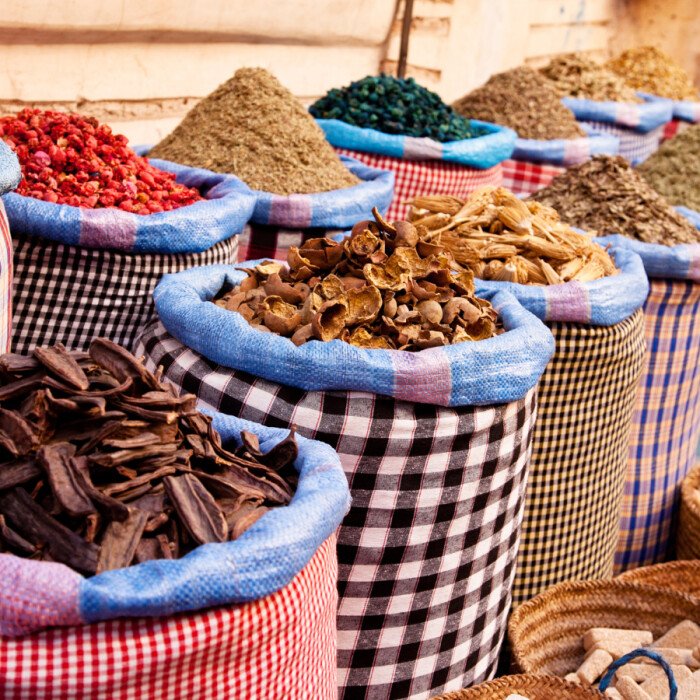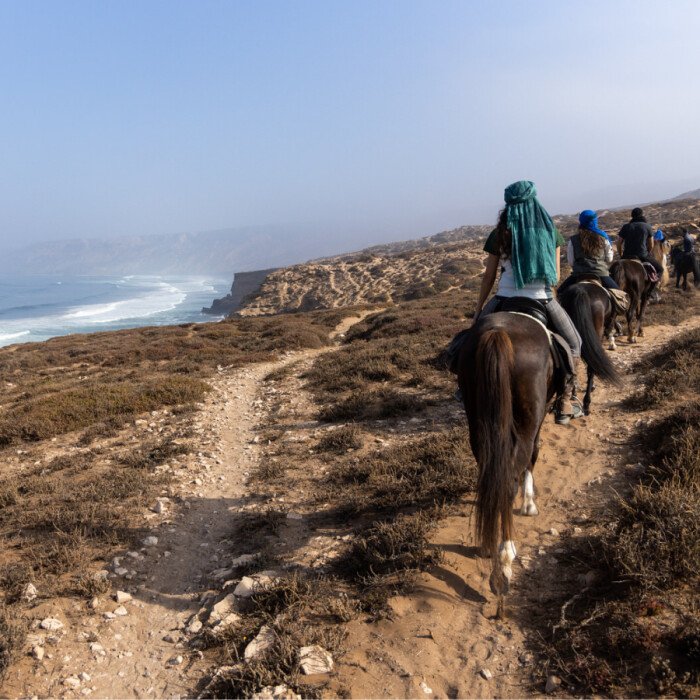Gisela’s authentic story: seven days on horseback along Morocco’s Atlantic coast, through wild nature, deep connections, and the warm welcome of an unforgettable journey.

Gisela Schleske joined the Costa Atlantica Trail in April 2025. Just a few days after returning home, she sent us a beautiful email and a personal story about her experience. We’re happy to share it here on the blog, because it answers many of the questions people usually ask before setting off.
If you have doubts, or are simply curious to know what our treks are really like — and how our horses behave — here’s what someone who’s been there has to say.
Now, over to Gisela
After spending seven days on the Atlantic Coast Ride with “my” Aragon, I’d like to share some answers with those who will ride after me — answers to the questions that kept running through my mind before I left.
What will the food be like? Will I be able to rest? What kind of bond will I have with my horse, with the group, and with the guides? And how will Morocco welcome me?
Now that I’m back home, after this beautiful experience, here’s what I can tell you.
My riding background
I’m sixty years old, I live in Freiburg, in southern Germany, and I don’t own a horse. As a child and teenager, I often rode outdoors, teaching myself as I went. After a twenty-year break, I started riding again five years ago.
For the past two years, I’ve been taking regular lessons with a dressage rider (Tamara Kubias, who specializes in vertical riding), from whom I’ve learned a lot about riding in a way that is harmonious and respectful of the horse. As a spectator at Manuel Oliveira’s clinics in Waal, I also had the opportunity to learn something valuable from him: the right way to relate to stallions.
Eating and sleeping: here’s how it went

From the very first meal — with a stunning view of the ocean near Agadir — I was impressed. And not just by the scenery. As a doctor, food is always a key point for me, and what I found here exceeded all expectations. Every day we had two hot meals, always prepared by the same cook, using fresh ingredients: vegetables, legumes, fruit, meat, fish, and eggs. There was always a full vegetarian option as well. Breakfast included fresh juices (up to four different kinds each morning) and homemade pancakes. Throughout the week, no one in our group experienced any discomfort. Water was always plentiful and provided in sealed bottles.
Sleeping in a tent, with others, was one of my main concerns. But I ended up sleeping deeply every night. Maybe it was the comfort of the mattresses, the Berber carpets on the floor, the colorful tent fabric… or perhaps the ocean breeze and the calm breathing of the horses just outside.
Even the camp toilet was always clean and odor-free. And all of us — myself included — noticed how regular our digestion was during the whole trip. Probably also thanks to the quality of the food.
How physically demanding is it?
The saddle was surprisingly comfortable — not a single ache or pressure point. Only two days after coming back did I feel a bit of soreness. During the trek, though, I felt great — both physically and mentally — and I could have easily kept riding for another week.
Before leaving, I was worried it might be too demanding, but I was pleasantly surprised: the excitement of the landscapes, the horses, and each day in the saddle far outweighed any fatigue.
What are the horses like, and how are they treated?
All the horses were in excellent condition: shiny coats, lean muscles, bright eyes. They were energetic and eager to move, yet sure-footed even in the most challenging terrain.
What struck me wasn’t just their health, but the way they carry themselves — elegant, collected, proud. Not dull school horses, but lively, responsive partners deeply attuned to the people guiding them.
My horse, Aragon, let himself be touched and saddled with ease. But it took a bit of time to understand what kind of brush he liked and how much pressure he preferred. At first, he was a little reserved. Later, he started to enjoy the contact. One day, as I was brushing his long, curly mane — nearly 50 cm — he actually fell asleep under my hands.
Not all stallions, however, are cuddly. One fellow rider was hoping for an affectionate horse, but hers wasn’t that kind. Mustapha, one of the guides, helped her find a new way to connect. And in the end, she found her cuddles with two other horses who were always open to affection.
As for feeding, Omar — the owner of the stables — showed me how much he cares about a varied, balanced diet. Each horse receives a carefully designed mix. What surprised me was how little the horses here eat and drink compared to our horses in Germany. They’re not food-aggressive, they don’t try to snack while walking, and even with longer pauses between meals, they stay calm, focused, and well-balanced.
How do the horses behave in a group?
I was really curious to find out what it would be like to spend seven days riding among 16 stallions (one of the horses was a gelding). What I quickly learned is that distance between horses is key. It takes attention — and sensitivity. Some like to be close to others, while some need their space.
Aragon, my horse, always kept an eye on the whole group, but he was so responsive to my cues that I could easily ride him out of sync with the herd. Even at a gallop, we set our own pace without being distracted. On the beach, for example, he let me slow down, even if the others passed us. But when I let him go, he would gallop for long stretches with power and joy — always under control, even at full speed. His energy felt limitless. Even after long stretches in the dunes — which felt like riding through deep snow — he never seemed to tire.
One very experienced rider, who was participating with her two daughters and works in the equestrian world, told me something that stuck with me: in her opinion, all the horses were exceptionally well trained and, with a competent rider, responded with great sensitivity.
Maybe what truly makes a stallion special — beyond his elegance — is his courage. None of the horses showed any fear: not of flapping plastic bags, not of buses, trucks, carts, nor of sudden encounters with donkeys, camels, barking dogs, sheep, goats or beachgoers.
What are the guides like?
During our journey, we were accompanied by Erica, Hassan, and Omar. Erica and Omar are the owners of the stables — two wonderful people, also a couple in life, and it shows. They share a natural, simple, and affectionate kindness. Hassan, Omar’s older brother, often rode at the front with a young, challenging horse. Watching him ride was a pleasure: never any force, never any tension. He never restricted the horse’s neck — he simply let it move forward, calmly and confidently.
From the very beginning, he told me that Aragon would be a great opportunity for me. And throughout the tour, he kept encouraging me with kind words about how I was interacting with my horse. Mustapha, who was part of the ground crew this time, was also always present. On the second day, I had tried to be a bit more authoritarian with Aragon, who at first used to neigh loudly and often. But Mustapha told me, “Give him sugar, not pressure.” I took it as an invitation to choose gentle firmness — to transmit confidence without rigidity.
So I began asking a little more from him: a few small exercises, a transition from walk to trot, then back to walk. And within two days, Aragon no longer felt the need to draw attention with loud neighs. He began to calm down, even during breaks, without pawing the ground or snorting to get noticed.
How are horses and riders matched?
.png)
At the time of booking, I was asked about my experience with horses and what kind of match I was hoping for. For Erica, this part is essential: horse and rider really need to meet — and connect. Before the start of the trek, she takes the time to consider who might work well together. She always talks it over with Omar too, who has a remarkable intuition when it comes to reading both people and animals.
For each horse, Erica shares a little story. They’re not just names or numbers — they have personalities, ways of being. She explains how each horse prefers to be treated, what makes them feel comfortable. By the end of the week, all fourteen of us felt like we had been paired with the right horse. Each of us, in our own way, had built a bond.
Of course, not everyone spent the same amount of time with their horse outside of riding. But those who wanted to were always free to groom, feed, and simply be with their horse. No one told you how or how much. The guides were always available to answer questions or check the saddle, but the real connection — that was yours to create.
Personally, I felt that my desire to get to know Aragon beyond the riding itself was something they understood — and appreciated. And so, day by day, the trust between us grew. The more we got to know each other, the more natural our connection became. It was also clear that the horses were happy — they enjoyed the tour, and they seemed to thrive in the strength and rhythm of the herd.
What was the route like?
The route is not easy — and that’s exactly what makes it so fascinating. It’s varied, at times challenging. The horses that take it on aren’t for beginners: they are well-trained, sensitive animals who deserve to be ridden with a light, independent seat — and a great deal of trust.
Aragon, for example, would always pause before a difficult descent. He would observe, think, and only then decide where to place his hooves. In those moments, pushing him forward would have been a mistake. A trek on terrain like this — at times truly demanding, with steep drops — means relying on the partnership between horse and rider, and trusting the horse’s ability to carry us safely.
I was amazed and enchanted by the variety of landscapes. We rode through farmland dotted with herds of goats and sheep, then crossed arid, desert-like areas that sloped down toward the wild sea. We saw baby camels frightened by our presence, running to their mothers — who greeted us with warning hisses, completely ignored by the horses. We even saw goats climbing several meters up into argan trees. Every lunch break, every place we slept, was surrounded by extraordinary natural beauty — always with a breathtaking view, often of the ocean.
What’s it like to travel in Morocco as a solo woman?
This was my fourth time in Morocco. Twenty years ago, vendors were more direct and insistent. Today, I feel the country has found a good balance in how it welcomes visitors — especially Europeans. In Essaouira and Marrakech, I moved around freely and felt completely at ease.
There are modern cafés and restaurants everywhere, with offerings and variety that rival those in New York. At the same time, traditional shops and eateries are still very much present. Since I first came to Morocco, the condition of the roads and public lighting has also improved greatly.
One thing that always strikes me is the kindness of the people. Whether it’s a farmer, a street vendor, or a shopkeeper — a smile or a greeting is always met with another smile and another greeting. They may seem like small gestures, but they say a lot about this country.



